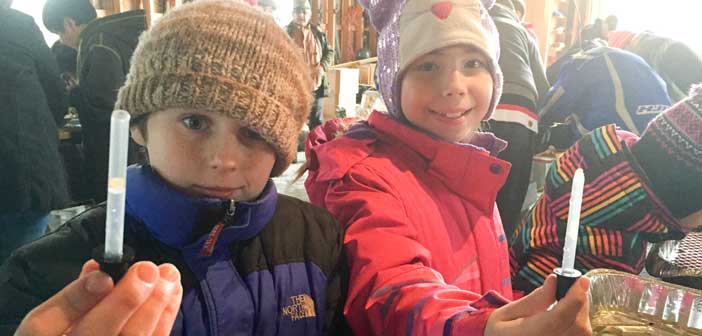NORTON’S CREEK—As has become a December tradition, volunteers with the local fish and game clubs, Manitoulin Streams, the Manitoulin Area Stewardship Council and Island elementary school students gathered at the Burke Pennie homestead on Bidwell Road to help replenish nearby Norton’s Creek’s brook trout population.
Dressed in warm winter clothes and armed with eye droppers, the volunteers and students delicately sucked up brook trout ‘eyed eggs’ into the droppers before gently pushing them back out into Scotty incubator boxes—10,000 times.
Once each of the 10 boxes was filled with the next generation of brook trout, the group headed for Norton’s Creek to plant them.
The boxes were placed mid-stream where the eyed eggs will continue to grow, being rotated in their boxes constantly by the fast moving waters of the stream. Once they hatch, the spawn will eat their yolk sacks and swim free of the boxes to bury themselves in the spawning gravel that was placed nearby. Those that survive (there is a 90 percent survival rate) will return each year to spawn at Norton’s Creek. The stream has undergone a major transformation since 2008.
In the summer of 2008, Manitoulin Streams contacted College Boreal to conduct electrofishing and invertebrate assessments along the upper and lower reach of Norton’s Creek, Manitoulin Streams coordinator Seija Deschenes explained. “They found that there were no brook trout caught throughout the upper reach of the creek which included many different sample sites,” she said. “We started out by restricting livestock from accessing the creek through installing about 700 metres of cedar rail fencing and 300 metres of page wire fencing, with the help of volunteers. We then started restoring the in-stream structure of the creek, reducing the width by stabilizing the shoreline with cobble and boulders and increasing the depth of the water by installing weeping weirs throughout the creek.”
Volunteers also came out to help plant almost 2,500 native trees and shrubs to create new riparian (the interface between land and water) habitat. Volunteers have included the Lake Manitou Area Association, the Little Current Fish and Game Club, Stewardship Rangers from the Ministry of Natural Resources, Assiginack and Lakeview Public Schools, Manitoulin Streams members, local landowners along Bidwell Road and the family and friends of the Hutton family.
“It really is a community event that brings all of us together to reach a common goal of restoring Norton’s creek,” Ms. Deschenes said. “We even had the Minister of Natural Resources at the time, the Honorable Donna Cansfield, come out to Norton’s

to see the great efforts made by volunteers of restoring Norton’s Creek.”
Norton’s Creek has undergone two electrofishing and invertebrate surveys since 2008. In 2011, three sites along the creek were sampled with a total of nine brook trout being caught, an average length of 122 millimeters. In 2013, another three sites were once again surveyed and they found 24 brook trout an average of 131 millimeters. This is great news, as it shows that the numbers, and size of the fish, are both increasing. Other species of fish caught included mud minnows, red bellied dace, creek chub, spottail shiners, white sucker, five spine stickleback, longnose dace, mottled sculpin and yellow-bellied dace.
Invertebrate samples also showed a good number of mayflies, caddisflies and stoneflies in Norton’s Creek, “which are excellent indicators of good water quality,” Ms. Deschenes explained.
“So far 40,000 Lake Nipigon strain brook trout eggs from the Hill’s Lake Hatchery in Englehart have been stocked into Norton’s Creek with the help of volunteers and the generosity of the Hutton family for allowing us to use their garage as a base for stocking the Scotty boxes,” she added. “It is a great experience for the students from Lakeview and Assiginack Schools to be able to participate in this kind of stewardship activity and it lets them be a part of the solution. The legacy of Bob Hutton, who was tragically taken away from us too early, is continuing through these community stewardship efforts to see through with his dream to restore Norton’s Creek to the historic brook trout stream he remembered as a child.”
Manitoulin Streams has plenty more going on besides Norton’s Creek, including an upcoming partnership with the Township of Billings to conduct stream rehabilitation at three sites at the lower end of the Kagawong River in 2015. The Township of Billings is worried that this popular trail system is going to be compromised by erosion of the banks, destroying this very popular tourist hiking trail. Problems identified at these sites include channel widening by erosion causing sedimentation and reducing water levels, a split flow in the channel causing some of the critical spawning habitat to be impacted by fluctuating water levels due to the hydro dams situated along the river, adjustments required to the existing pools and a lack of riparian and canopy vegetation in some areas.
The goal of this project is to restore and rehabilitate the recreational fisheries habitat along the Kagawong River, working with the Township of Billings and engaging local community members in stewardship activities, Ms. Deschenes explained. “This will enhance sustainability and ongoing productivity of Canada’s recreational fisheries through the protection of water quality, restoration and enhancement of aquatic and fish habitat and by improving fish passage or connectivity to critical spawning habitat for this Lake Huron tributary. This restoration project will provide benefits for this rural community that depends on this recreational fishery and tourism as main economic drivers in this region. By improving the river’s hydrological function, fish passage and spawning habitat it will help provide migrating salmonids such as coho, pink and Chinook salmon and rainbow trout better access up the one kilometre river reach (to Bridal Veil Falls) to facilitate the completion of their life cycle thereby improving our recreational fishing opportunities.
The organization also will also be working with a local producer in Spring Bay to help with livestock restriction in Grimesthorpe Creek. “We will be installing fencing, a livestock watering ramp and crossing and we will be looking for help from volunteers to plant native trees and shrubs providing a riparian area along the creek,” she added.
“We will still be providing educational stream side tours (Stream Detective) if anyone is interested in signing up in the summer in Providence Bay and we are currently trying to get another invasive species liaison for Manitoulin Island in order to provide educational awareness and share this important information at community events this summer,” Ms. Deschenes concluded.
To reach Manitoulin Streams, contact Ms. Deschenes at 705-859-1653 or email streams@amtelecom.net.





